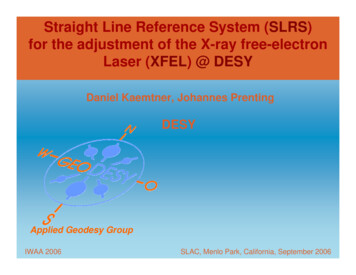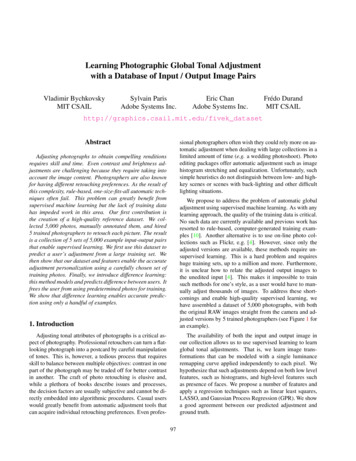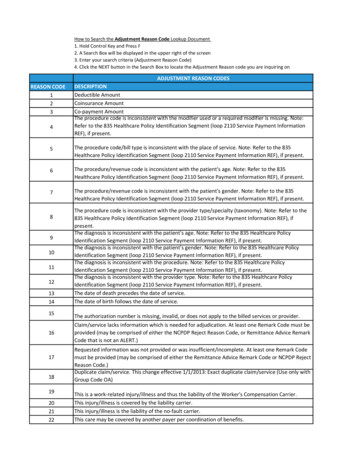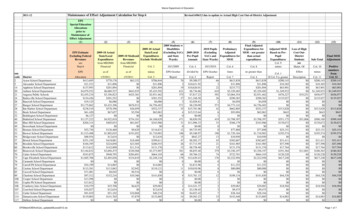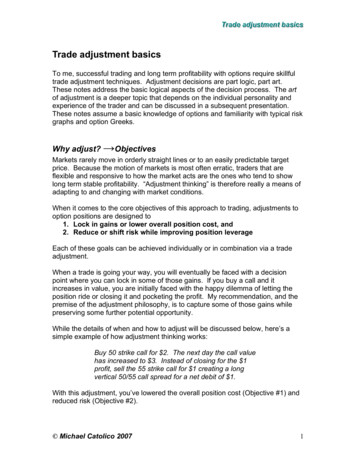
Transcription
TTrraaddee aaddjjuussttmmeenntt bbaassiiccssTrade adjustment basicsTo me, successful trading and long term profitability with options require skillfultrade adjustment techniques. Adjustment decisions are part logic, part art.These notes address the basic logical aspects of the decision process. The artof adjustment is a deeper topic that depends on the individual personality andexperience of the trader and can be discussed in a subsequent presentation.These notes assume a basic knowledge of options and familiarity with typical riskgraphs and option Greeks.Why adjust? ObjectivesMarkets rarely move in orderly straight lines or to an easily predictable targetprice. Because the motion of markets is most often erratic, traders that areflexible and responsive to how the market acts are the ones who tend to showlong term stable profitability. “Adjustment thinking” is therefore really a means ofadapting to and changing with market conditions.When it comes to the core objectives of this approach to trading, adjustments tooption positions are designed to1. Lock in gains or lower overall position cost, and2. Reduce or shift risk while improving position leverageEach of these goals can be achieved individually or in combination via a tradeadjustment.When a trade is going your way, you will eventually be faced with a decisionpoint where you can lock in some of those gains. If you buy a call and itincreases in value, you are initially faced with the happy dilemma of letting theposition ride or closing it and pocketing the profit. My recommendation, and thepremise of the adjustment philosophy, is to capture some of those gains whilepreserving some further potential opportunity.While the details of when and how to adjust will be discussed below, here’s asimple example of how adjustment thinking works:Buy 50 strike call for 2. The next day the call valuehas increased to 3. Instead of closing for the 1profit, sell the 55 strike call for 1 creating a longvertical 50/55 call spread for a net debit of 1.With this adjustment, you’ve lowered the overall position cost (Objective #1) andreduced risk (Objective #2). Michael Catolico 20071
TTrraaddee aaddjjuussttmmeenntt bbaassiiccssOf course not every trade will show an immediate profit. Adjustments cannot turnlosers into winners, but, by pursuing the two key objectives, you can often set upthe dynamics that turn these losing trades around. Thus, when a trade is notgoing your way, rather than close to take the loss, you can decide if makingsome kind of adjustment will direct you toward the key objectives.Example:Originally long a 50 strike call for 2. The next daythe call value declines to 1. Instead of taking theloss by closing the position, sell two 55 strike calls for 0.50 each leaving you with a net ratio trade of 1 50call/-2 55 calls for a net debit of 1.With this adjustment you’ve lowered the overall position cost (Objective #1) whileshifting and aligning the profit zone of the position with the market (Objective #2).What I mean by “aligning the profit zone” is simply that the adjusted position willrecover value more quickly if the underlying price returns to your original bullishperspective. I’ll defer discussion of the added risk that the extra short 55 calladds for now, but logically try to focus on how the value of the 50 strike willrecover faster if the cost of the trade is 1 versus the original 2 debit.SummaryThe goal of adjustment thinking is ultimately to find ways to improve your longterm trading success. The key benefit of making adjustments – as opposed tosimply closing winning or losing trades – is to continually fine tune your positionto extract some further potential reward. Look for opportunities to lock in gainsand/or shift your profit zone more favorably. Michael Catolico 20072
TTrraaddee aaddjjuussttmmeenntt bbaassiiccssWhat are adjustment trades? Fundamental position typesIndividual options are like building blocks. They can be combined in countlessways with nearly infinite reward and risk profiles. But when it comes right downto basics, there are four fundamental types of trade that need to be mastered formaking adjustments to just about any ch of these trade types can be used to quickly modify and morph any exitingtrade to meet the adjustment objectives. To advance your adjustment thinkingability, you need to develop an ease and comfort level with converting into andout of these four types of position. It’s likely that these trade types are alreadyfamiliar to you, but here is a quick review of how the trades are constructed witha particular focus on how they operate for adjustment purposes.Vertical spreadsA vertical spread consists of equal units of long and short options at differentstrikes. If the long strike is lower than the short strike, it is considered a bullishvertical. If the long strike is higher than the short strike, it is a bearish vertical.[NOTE: I don’t distinguish between calls and puts since they can be usedinterchangeably via synthetic relationships. Though for trading beginners, it maybe helpful to think in terms of all calls to visualize the trade.]The key aspects of the vertical trade are 1) directionality (the trade maintains acorrelation and sensitivity to price movement) and 2) regional leverage. By“regional” leverage, I’m referring to the powerful increase in reward to risk thatthe vertical has in the localized price zone. Strictly speaking, a plain long call, forexample, has “infinite” reward to risk potential. But realistically, we have to lookat each trading situation with a sense of the relative probabilities of pricemovement. By reducing overall cost and shifting the price point at which thetrade becomes profitable, the vertical position radically improves the localizedreward/risk potential.Butterfly spreadsA butterfly consists of a long vertical and short vertical spread with the longstrikes outside (above and below) the short strikes. Typical “fly” has two shortunits at the same strike. Example: 1 50C/-2 55C/ 1 60C. Variations of the flyare typically referred to as Condors where the short strikes are not the same.Example: 1 50C/-1 55C/-1 60C/ 1 65C. The key aspects of the butterfly are 1) Michael Catolico 20073
TTrraaddee aaddjjuussttmmeenntt bbaassiiccssfixed risk and 2) neutrality over a price zone (in Greek terminology, “thetapositive”). These trades can be used as opening positions or as adjustments.Flys help ratchet the profit zone to align the “fattest” reward potential with wherethe market is currently trading. Since adjustment thinking is all about respondingto the current market, the fly trade is an ideal tool for floating a positionbackwards and forwards to meet changes in price and time. I’ll demonstratebelow how the fly is frequently the most useful tool for managing a trade.Ratio spreadsRatio spreads are simply verticals with at least one additional short unit. Themost common form is a one by two spread such as 1 50C/-2 55C. Ratio tradesare the ultimate defense against a losing position. The key aspects of ratiospreads are 1) cost reduction and 2) risk displacement. As the underlyingprice moves against your current position, you need to look for opportunities thatshed some of the cost of holding on to the trade. Selling out of the moneyoptions against a core position is a way to minimize some of that cost.Box spreadsA box is a long call spread and a long put spread at the same strikes. Unlessyou are a floor trader the only time you'd ever be inclined to trade a box is whenyou have originally traded one or the other verticals (or even more rarely, one ofthe respective strangles) and currently have a profit.The box allows you to lock in profit and then treat the separate pieces as newverticals to react to at the next step. I like to think of the box as a way to getsome breathing space in a trade when I’m not really confident of what willhappen next. It is also akin to "splitting pairs" in blackjack for those familiar withcard strategy.You can of course simply close a winning trade for a profit and skip the extracommissions. But it's worth occasionally exploring the box as a way to grow orevolve a winning position. It makes sense to look at doing a box trade if you arein a volatile entity that seems to be doing what assets typically do: meander inzigzag fashion back and forth. So for example, say you are in a profitable 50/55call spread. You have the choice to sell it outright or do the box by buying the55/50 put spread. If you buy the box, you have a guaranteed lock on thedifference between the 5-point spread and what you paid for the net box position.If you do nothing after this point, you will just collect the difference at expiration.But if the underlying asset price moves around you now have a couple separatebases to work additional trades from. Let’s say that after you enter the box, theunderlying drops back to the level where you bought the original call spread.You can now sell that put spread for a bit of a profit and you are back in youroriginal position for a reduced cost. If the asset goes back up, you do the box Michael Catolico 20074
TTrraaddee aaddjjuussttmmeenntt bbaassiiccssagain - all the while chipping down that cost of original entry, responding to themarket, and setting yourself up for additional moves.[One caveat: make sure you understand boxes thoroughly which means, forinstance, looking out for dividend situations where you might unexpectedly getyour short positions exercised as well as being prepared for pin risk atexpiration.]Practicing “option gymnastics”To really get comfortable and hone your trading skills, it’s a good exercise tovisualize how to turn any trade into one of the four fundamental trade types –including converting the four trades into any of the others.Following the adjacentdiagram, you should begin toattune your tradingsensibilities to be able tovisualize how any of the tradetypes can become one of theothers. By adding orsubtracting the pieces, aposition can quickly beadapted to suit changingconditions.VerticalFlyRatioBoxAs an exercise, ignore prices and concentrate on what combinations you’d needto execute to convert any fundamental trade into one of the others.Example: Morphing a vertical positionAssume a starting position that is a vertical callspread where you are long one 50 call and short one55 call.To create a ratio: sell one 55 call to make a netposition of 1 50C/-2 55CTo create a butterfly: sell one 55 call and buy one 60call to make a net position of 1 50C/-2 55C/ 1 60CTo create a box: sell one 50 put and buy one 55 put tomake a net position of 1 50C/-1 50 P/-1 55C/ 1 55P Michael Catolico 20075
TTrraaddee aaddjjuussttmmeenntt bbaassiiccssI’d suggest you take some time to work through all the other permutations in thediagram to develop greater dexterity with converting each trade type.A note on timeWhile adjustment thinking is most concerned with adapting to price changes, theother key factor impacting a position is, of course, time. If the underlying assetseems to come to a standstill after entering your option trade, you have to beprepared to adapt to that fact. Time can erode a long premium position (i.e. thetanegative) sometimes in just as devastating a fashion as undesired pricemovement. In a situation where you are starting to experience unacceptabledecay in your premium, you can still select from the fundamental trade types toadapt your position. You’’ seek out ways to make your position theta positiveand that will lead you to either the butterfly or ratio alternatives.SummaryTrade adjustment basics require you to develop a facility with turning one type oftrade into another that is more suited to current market conditions and prices.The four fundamental positions described here – vertical, butterfly, ratio and box– are the most useful tools for building the necessary skills. Michael Catolico 20076
TTrraaddee aaddjjuussttmmeenntt bbaassiiccssHow to adjust? Key adjustment methods and techniquesIf you’ve mastered – or at least increased your comfort level with - the mentalgymnastics of converting fundamental trade types, you are ready to apply theseskills to adjustment practice. Adjustment thinking is a (mostly) logical processthat initially uses the foundational trades in sequence. The decision tree belowshows the process from an original long call position but the tree applies to anytype of trade along the decision paths as an underlying vehicle works its zigzagprice motion.As you advance your trading abilities, you will likely veer from the sequence butlearning has to start somewhere and with this decision sequence you can,hopefully, begin to see trading like a chess game where you prepare each movewith an eye toward two, three or more countermoves and adaptations into thefuture.From any starting point, as the underlying price moves up (“ ” on the decisiontree) or down (“-“), you will look to morph your position by adding or subtractingthe appropriate pieces to create the subsequent position in the sequence. Michael Catolico 20077
TTrraaddee aaddjjuussttmmeenntt bbaassiiccssWorking the decision treeThe primary types of adjustments you’ll use are tied the movement of prices.While option prices change for a variety of reasons, the main concern here iswith the movement of the underlying asset. Graphically you can see the processfor selecting adjustments in the following decision tree.Adjustment decision tree Long call Vertical- RatioFlyLong call- Fly roll (ratio)Fly roll (condor)VerticalReverse fly roll(Ratio)Fly roll (Opencondor ratio) Michael Catolico 20078
TTrraaddee aaddjjuussttmmeenntt bbaassiiccssThe following examples will help illustrate how each adjustment happens andsome of the rationale behind each decision. While working through the examplespay particular attention to how each adjustment alters the cost basis and shiftsthe prospects for profitability. I’
Trade adjustment basics To me, successful trading and long term profitability with options require skillful trade adjustment techniques. Adjustment decisions are part logic, part art. These notes address the basic logical aspects of the decision process. The art of adjustment is a deeper topic that depends on the individual personality and experience of the trader and can be discussed in a .

